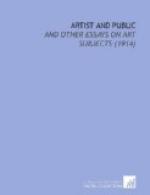But design is something more than the essential quality of mural decoration—it is the common basis of all the arts, the essential thing in art itself. Each of the arts has its qualities proper to it alone, and it may be right to estimate the painter, the sculptor, the architect, or the musician according to his eminence in those qualities which are distinctive of his particular art and which separate it most sharply from the other arts. In that sense we are right to call Frans Hals a greater painter than Raphael. But if we estimate a man’s artistry by the same standard, whatever the form of art in which it expresses itself, rating him by his power of co-ordinating and composing notes or forms or colors into a harmonious and beautiful unity, then must we place Raphael pretty near where he used to be placed, admitting but a choice few of the very greatest to any equality with him. If we no longer call him “the prince of painters” we must call him one of the greatest artists among those who have practised the art of painting.
V
TWO WAYS OF PAINTING
Among the modern paintings in the Metropolitan Museum is a brilliant and altogether remarkable little picture by John Sargent, entitled “The Hermit” (Pl. 21). Mr. Sargent is a portrait-painter by vocation, and the public knows him best as a penetrating and sometimes cruel reader of human character. He is a mural painter by avocation and capable, on occasion, of a monumental formality. In this picture, as in the wonderful collection of watercolors in the Brooklyn Institute of Arts and Sciences, one fancies one sees the essential John Sargent, working for himself alone without regard to external demands, and doing what he really cares most to do. In such work he is a modern of the moderns and, in the broadest sense of the word, a thorough Impressionist. Not that he shows himself a disciple of Monet or occupies himself with the broken touch or the division of tones—his method is as direct as that of Sorolla and his impressionism is of the same kind—a bending of all his energies to the vivid realization of the effect of the scene rendered as one might perceive it in the first flash of vision if one came upon it unexpectedly. This picture is better than Sorolla—it is better than almost any one. It is perhaps the most astonishing realization of the modern ideal, the most accomplished transcript of the actual appearance of nature, that has yet been produced. It is because of its great merit, because of its extraordinary success in what it attempts, that it leads one to the serious consideration of the nature of the attempt and of the gain and loss involved in the choice that modern art has made.




